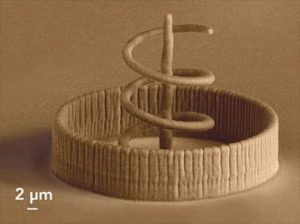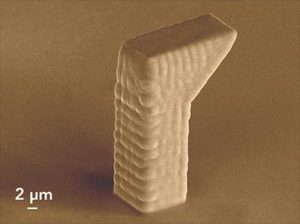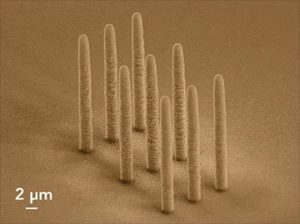 Nanotechnology startup Cytosurge, an ETH Zurich spin-off company, was founded nine years ago, and develops, manufactures, and distributes innovative, high-precision nanotechnology metal 3D printers based on its patented FluidFM technology, which stands for fluidic force microscopy and has many applications in life sciences and biophysics. Its award-winning microscale metal 3D printing system, the FluidFM µ3Dprinter, has been around for a couple of years now, and was further developed into a more consumer-friendly process last summer. The standalone system is able to 3D print pure metal objects, and has just received a pretty major design upgrade.
Nanotechnology startup Cytosurge, an ETH Zurich spin-off company, was founded nine years ago, and develops, manufactures, and distributes innovative, high-precision nanotechnology metal 3D printers based on its patented FluidFM technology, which stands for fluidic force microscopy and has many applications in life sciences and biophysics. Its award-winning microscale metal 3D printing system, the FluidFM µ3Dprinter, has been around for a couple of years now, and was further developed into a more consumer-friendly process last summer. The standalone system is able to 3D print pure metal objects, and has just received a pretty major design upgrade.
 The FluidFM µ3Dprinter can already print metal structures ranging from 1 μm3 to 1,000,000 µm3, which is unheard of for other technologies. An electrochemical process, which works at room temperature, 3D prints a pure, high-quality metal, and can also fabricate overhanging structures with 90° angles without the use of support structures or post-processing.
The FluidFM µ3Dprinter can already print metal structures ranging from 1 μm3 to 1,000,000 µm3, which is unheard of for other technologies. An electrochemical process, which works at room temperature, 3D prints a pure, high-quality metal, and can also fabricate overhanging structures with 90° angles without the use of support structures or post-processing.
But now, it features a new function that’s pretty unique – it can 3D print, with pinpoint (micrometer) accuracy, onto existing structures.
FluidFM technology combines force microscopy and microfluidics features by adding microscopic channels into force sensitive probes, or print tips. This results in the company’s FluidFM iontip, which makes the whole micro 3D printing process possible.
A very small volume of ion-containing liquid can be pumped through the iontip’s interior microscopic channel, then dispensed through a sub-micrometer aperture at the tip. The apertures, which can be as tiny as 300 nanometers, make it possible to achieve flow rates as small as a few femtoliters per second, which is a million times smaller than even the very best flow sensors can pick up on. In addition, the FluidFM iontips use their force-sensing capability to offer real-time process control during the print process. This makes it possible to 3D print complex, pure metal objects at the micrometer scale.
- Combination of structures.
- Solid objects with overhang.
- Array of pillars.
Cytosurge’s new pinpoint metal 3D printing is possible due to two state-of-the-art, high-resolution cameras that have been integrated directly into the FluidFM µ3Dprinter. These cameras make visualization of the finished structures possible, and also ensure automated loading of the FluidFM iontips, printer setup, calibration, and the computer-assisted alignment that makes it possible to print on pre-existing structures.
The top view camera images the surface or object about to be printed on, while the bottom view one mostly views internal system processes, such as controlling the FluidFM iontip’s automated gripping motions. Using the FluidFM µ3Dprinter’s live, high-resolution video, it’s possible to manually select the exact position of the surface or object that will be printed on, and then set it as the 3D printing process starting point. This allows the user to 3D print metallic objects on contact pads which are already pre-defined on the surface of micro-electromechanical-systems (MEMS) or an integrated circuit, like a microchip.
The FluidFM μ3Dprinter’s unique new function of 3D printing structures, with exacting, pinpoint accuracy, directly onto surfaces and objects could potentially revolutionize micromanufacturing by combining traditional microfabrication techniques with 3D printing to create complex metal objects.
Discuss metal 3D printing and other 3D printing topics at 3DPrintBoard.com or share your thoughts in the Facebook comments below.
[Images: Cytosurge]
Subscribe to Our Email Newsletter
Stay up-to-date on all the latest news from the 3D printing industry and receive information and offers from third party vendors.
You May Also Like
Gorilla Sports GE’s First 3D Printed Titanium Cast
How do you help a gorilla with a broken arm? Sounds like the start of a bad joke a zookeeper might tell, but it’s an actual dilemma recently faced by...
Nylon 3D Printed Parts Made More Functional with Coatings & Colors
Parts 3D printed from polyamide (PA, Nylon) 12 using powder bed fusion (PBF) are a mainstay in the additive manufacturing (AM) industry. While post-finishing processes have improved the porosity of...
$25M to Back Sintavia’s Largest Expansion of Metal 3D Printing Capacity Since 2019
Sintavia, the digital manufacturing company specializing in mission-critical parts for strategic sectors, announced a $25 million investment to increase its production capacity, the largest expansion to its operations since 2019....
Velo3D Initiates Public Offering in a Bid to Strengthen Financial Foundations and Drive Future Growth
Velo3D (NYSE: VLD) has been among a number of publicly traded 3D printing firms that have attempted to weather the current macroeconomic climate. After posting a challenging financial report for 2023,...



































